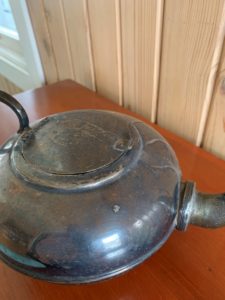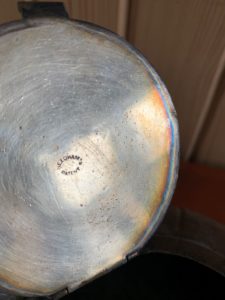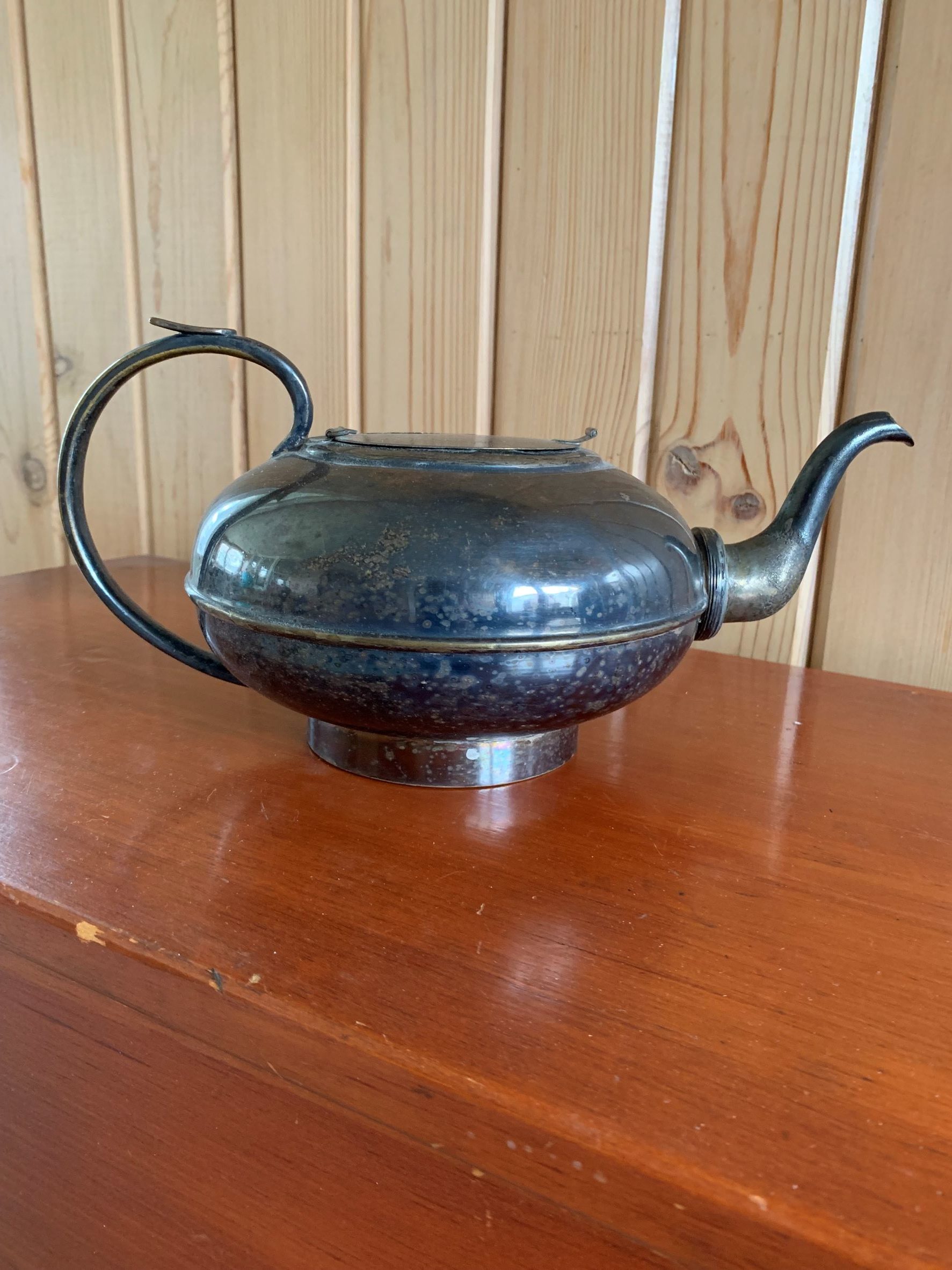Sometimes an object comes your way that’s a real headscratcher. When that happens, the basic problem is to figure out what it is. You can’t move on without that. And when the only clue you have is the physical existence of the thing itself, like a detective, you must begin with the body in front of you. What can you see? That’s the core question, which leads logically to other, more complex questions—How was it made? What is it made of? Where was it made? When? Who made it?—leading you bit by bit to a conclusion (or at least a hypothesis) about what it is, where it fits in material culture, and what it means today—both in historical value and in monetary value.
Let’s take an interesting example from my files: The Case of the Ugly Teapot.
What can you see? A teapot of course, but it’s a very unusual teapot when you start to look more intentionally. First of  all, the spout looks like it was attached by a plumber! There’s nothing elegant or graceful about this teapot. I can’t imagine it being brought to the table for actual service. And there are other features that don’t look like any teapot I’ve ever seen in polite society. For instance, the thin lid’s hinge is pinned with a dangerous-looking piece of bent wire. The opening is not perfectly round, either, so the lid does not seal the pot, which any respectable teapot’s lid should. And another thing about that lid: the underside has what looks like a flame halo. Could it have been cut out with a torch? My impression from the basic once-over is that this teapot was never made for actual table use.
all, the spout looks like it was attached by a plumber! There’s nothing elegant or graceful about this teapot. I can’t imagine it being brought to the table for actual service. And there are other features that don’t look like any teapot I’ve ever seen in polite society. For instance, the thin lid’s hinge is pinned with a dangerous-looking piece of bent wire. The opening is not perfectly round, either, so the lid does not seal the pot, which any respectable teapot’s lid should. And another thing about that lid: the underside has what looks like a flame halo. Could it have been cut out with a torch? My impression from the basic once-over is that this teapot was never made for actual table use.
What is it made of? Well, obviously metal, but what kind? The magnet test reveals that it is entirely nonferrous. I know this because my magnet is not attracted to any part of it, so that eliminates iron and steel, but beyond that it’s really hard to say: silver over copper? tin? It’s too heavy to be aluminum and too light to be lead. The wear on the handle reveals a rosy/golden core, so it’s probably some alloy of copper and zinc or nickel with maybe a thin skin of silver, which is badly degraded and completely absent in spots. I suspect that parts of this pot began life as a proper silverplated teapot that was subsequently mutilated and cobbled together with other spare parts. A Frankenstein teapot.
Where and when was it made? Now this takes a bit more detailed inspection. From the outside there is nothing to suggest where or when it was made. I know it was purchased in the early 1990s in the United States, but there is nothing in style or decoration to suggest any particular time period or country of origin. So, let’s search for a mark of some kind. Bingo. Under the lid: “Needham’s patent.” Aha! That’s something I can work with. 
Who made it? If I can find out something about this Needham, I may also be able to say when it was made. There’s a lot of bang for the evidentiary buck in a mark, and I fairly quickly find (through an internet search) a silverplated calling card case with this exact mark. Through its auction description, I learn that Needham was in business 1889-1925 in Sheffield, England. Now I’m really getting somewhere! It wasn’t hard thereafter to discover that the Needhams were a family of cutlers, silver platers, and inventors in Sheffield going back to the 1700s.
As I searched further for information specifically about “Needham’s patents,”
I came across an interesting notice of an 1892 abridgement to Patent 5104 Stands for table use held by A.J. and H.C. Needham and W. Hendy. And there I found what I think is the smoking gun . . . er, teapot.
abridgement to Patent 5104 Stands for table use held by A.J. and H.C. Needham and W. Hendy. And there I found what I think is the smoking gun . . . er, teapot.
Why was it made? And now I can form a hypothesis about this thing. I think this is a prototype for a British patent application, not an actual production example of the invention. It was probably made in 1889 or 1890, around the time of the original application, to demonstrate the stand, not the pot per se. Now, of course, this is only my hypothesis. I don’t know for certain that it is a patent prototype, but now I can begin additional research from this hypothesis to learn more about the Needham family and their inventions, to try to document its existence in other ways. How it came to the US and eventually landed on my office bookshelf may never be knowable.
What does it mean today? The monetary value of this thing is, in my opinion, very low. Even though it is surely one of a kind, it’s ugly, it’s unusable, it’s in rough condition. But it does inspire conversation so, as a curiosity, it might be worth a few dollars. If it isn’t worth much as a teapot, is it worth anything as a prototype? Prototypes, like salesman’s samples and patent drawings, are indeed very collectible and some are quite valuable. The Hagley Museum and Library in Wilmington, DE, has an excellent collection of patent models. From such artifacts we can learn a great deal not only about industrial history but also about human ingenuity and the material concerns and values of societies at different historical eras. In late Victorian England, the pouring of tea was a matter of some social concern, but today not so much, so is there any historical value in this ugly teapot? Probably not. It’s incomplete in any case and it’s not even the star of the invention itself. No, it’s not worth anything really, except the 947 words I’ve given it.

